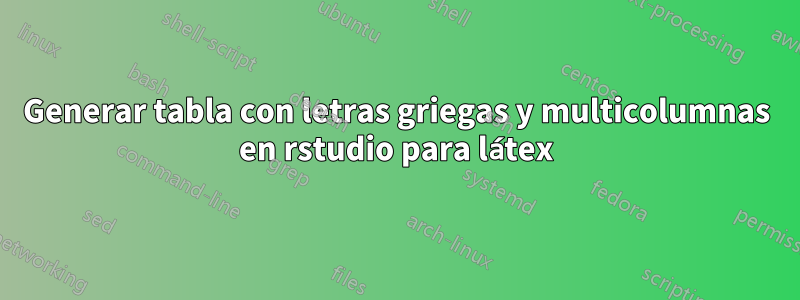
Con los comandos:
---
output: pdf_document
---
```{r, results='asis',message=FALSE,warning=FALSE}
library(knitr)
library(xtable)
url <- 'https://cdn.rawgit.com/fsbmat/StackOverflow/master/'
dt1 <- read.table(paste0(url, 'sim50.txt'), header = TRUE)
attach(dt1)
dt2 <- read.table(paste0(url, 'sim200.txt'), header = TRUE)
attach(dt2)
dt3 <- read.table(paste0(url, 'sim1000.txt'), header = TRUE)
attach(dt3)
gamma0=1.23
gamma1=0.07
gamma2=1.05
#gamma3=0.7
beta0=1.18
beta1=0.23
beta2=0.25
phi1 <- 0.69
rho <- 0.03
truevalue <- c(gamma0,gamma1,gamma2,beta0,beta1,beta2,phi1,rho)
eqm=function(x,theta){
N=length(x)
sqrt(sum(((x-theta)^2))/N)}
m <- dt1
m2 <- dt2
m3 <- dt3
eqmest=c(eqm(x=m[,1],theta=truevalue[1]),
eqm(x=m[,2],theta=truevalue[2]),
eqm(x=m[,3],theta=truevalue[3]),
eqm(x=m[,4],theta=truevalue[4]),
eqm(x=m[,5],theta=truevalue[5]),
eqm(x=m[,6],theta=truevalue[6]),
eqm(x=m[,7],theta=truevalue[7]),
eqm(x=m[,8],theta=truevalue[8]))
eqmest2=c(eqm(x=m2[,1],theta=truevalue[1]),
eqm(x=m2[,2],theta=truevalue[2]),
eqm(x=m2[,3],theta=truevalue[3]),
eqm(x=m2[,4],theta=truevalue[4]),
eqm(x=m2[,5],theta=truevalue[5]),
eqm(x=m2[,6],theta=truevalue[6]),
eqm(x=m2[,7],theta=truevalue[7]),
eqm(x=m2[,8],theta=truevalue[8]))
eqmest3=c(eqm(x=m3[,1],theta=truevalue[1]),
eqm(x=m3[,2],theta=truevalue[2]),
eqm(x=m3[,3],theta=truevalue[3]),
eqm(x=m3[,4],theta=truevalue[4]),
eqm(x=m3[,5],theta=truevalue[5]),
eqm(x=m3[,6],theta=truevalue[6]),
eqm(x=m3[,7],theta=truevalue[7]),
eqm(x=m3[,8],theta=truevalue[8]))
parameter <- c("gamma0 (mu2)","gamma1 (mu2)", "gamma2 (mu2)", "beta0 (mu1)", "beta1 (mu1)",
"beta2 (mu1)","phi1 (sd)","rho (cor)")
dt <- data.frame(Parameters=parameter,VV=truevalue,Mean=cbind(colMeans(dt1)),EQM=eqmest,
Mean=cbind(colMeans(dt2)),EQM=eqmest2,Mean=cbind(colMeans(dt3)),
EQM=eqmest3)
kable(dt, digits = 5, align = c('c','c','c','c','c','c','c','c'))
print(xtable(dt,digits=c(5,5,5,5,5,5,5,5,5), caption = "",align = rep("c",9)),
caption.placement = "top", include.rownames = FALSE, type = "latex")
```
Genero la siguiente tabla en rstudio para usar en mi archivo de látex:
¿Es posible generar la siguiente tabla, con letras griegas y varias columnas, con el comando xtableen el software Rstudio?
Si no, ¿es posible generar esto más simple?
Respuesta1
Con la ayuda de @nebi, fue posible completar la tabla como se deseaba. Simplemente elimine todo "NA" y "borre" manualmente en látex.
---
output: pdf_document
---
```{r, results='asis',message=FALSE,warning=FALSE}
library(knitr)
library(xtable)
url <- 'https://cdn.rawgit.com/fsbmat/StackOverflow/master/'
dt1 <- read.table(paste0(url, 'sim50.txt'), header = TRUE)
attach(dt1)
dt2 <- read.table(paste0(url, 'sim200.txt'), header = TRUE)
attach(dt2)
dt3 <- read.table(paste0(url, 'sim1000.txt'), header = TRUE)
attach(dt3)
gamma0=1.23
gamma1=0.07
gamma2=1.05
#gamma3=0.7
beta0=1.18
beta1=0.23
beta2=0.25
phi1 <- 0.69
rho <- 0.03
truevalue <- c(gamma0,gamma1,gamma2,beta0,beta1,beta2,phi1,rho)
eqm=function(x,theta){
N=length(x)
sqrt(sum(((x-theta)^2))/N)}
m <- dt1
m2 <- dt2
m3 <- dt3
eqmest=c(eqm(x=m[,1],theta=truevalue[1]),
eqm(x=m[,2],theta=truevalue[2]),
eqm(x=m[,3],theta=truevalue[3]),
eqm(x=m[,4],theta=truevalue[4]),
eqm(x=m[,5],theta=truevalue[5]),
eqm(x=m[,6],theta=truevalue[6]),
eqm(x=m[,7],theta=truevalue[7]),
eqm(x=m[,8],theta=truevalue[8]))
eqmest2=c(eqm(x=m2[,1],theta=truevalue[1]),
eqm(x=m2[,2],theta=truevalue[2]),
eqm(x=m2[,3],theta=truevalue[3]),
eqm(x=m2[,4],theta=truevalue[4]),
eqm(x=m2[,5],theta=truevalue[5]),
eqm(x=m2[,6],theta=truevalue[6]),
eqm(x=m2[,7],theta=truevalue[7]),
eqm(x=m2[,8],theta=truevalue[8]))
eqmest3=c(eqm(x=m3[,1],theta=truevalue[1]),
eqm(x=m3[,2],theta=truevalue[2]),
eqm(x=m3[,3],theta=truevalue[3]),
eqm(x=m3[,4],theta=truevalue[4]),
eqm(x=m3[,5],theta=truevalue[5]),
eqm(x=m3[,6],theta=truevalue[6]),
eqm(x=m3[,7],theta=truevalue[7]),
eqm(x=m3[,8],theta=truevalue[8]))
parameter <- c("$\\gamma_{1}$","$\\gamma_{2}$", "$\\gamma_{3}$", "$\\beta_{1}$", "$\\beta_{2}$","$\\beta_{3}$","$\\phi$","$\\rho$")
dt <- data.frame(Parâmetros=parameter,VV=truevalue,Clear=rep("NA",8),Média=cbind(colMeans(dt1)),EQM=eqmest,Clear=rep("NA",8),Média=cbind(colMeans(dt2)),EQM=eqmest2,Clear=rep("NA",8),Média=cbind(colMeans(dt3)),EQM=eqmest3)
print(xtable(dt,digits=c(5,5,5,5,5,5,5,5,5,5,5,5), caption = " ",align = rep("c",12)),
caption.placement = "top", include.rownames = FALSE,include.colnames = FALSE,
type = "latex",
sanitize.text.function = function(x) {x},add.to.row = list(
pos = list(0),
command = c(
"& &&\\multicolumn{2}{c}{n=50}&&\\multicolumn{2}{c}{n=200}&&\\multicolumn{2}{c}{n=1000} \\\\
\\cline{4-5} \\cline{7-8} \\cline{10-11}
Parâmetros & VV & Clear & Média & EQM& Clear & Média & EQM& Clear & Média & EQM\\\\"
)))
Respuesta2
en la funcionprint.xtable, hay diferentessanitize función diferente para agregar marcas en la tabla. Puedes echarle un vistazo a la pieza.4.1 Marcado en la tablaen elLa galería xtableviñeta ( vignette("xtableGallery"))
Para tu código, tienesprimeropara escapar del comando de látex (tu parameter variable(es decir$\\gamma 0 (\\mu 2)$ ) ysegundoluego para desinfectar su llamada print.xtable con el argumentosanitize.text.function = function(x) {x}
Para su ejemplo, para hacerlo reducible, no olvide explicar el archivo que está utilizando y llamar a los paquetes y bibliotecas.
Como archivo .Rmd, esto le damutatis mutandis
---
output: pdf_document
---
```{r, results='asis'}
library(knitr)
library(xtable)
url <- 'https://cdn.rawgit.com/fsbmat/StackOverflow/master/'
dt1 <- read.table(paste0(url, 'sim50.txt'), header = TRUE)
attach(dt1)
dt2 <- read.table(paste0(url, 'sim200.txt'), header = TRUE)
attach(dt2)
dt3 <- read.table(paste0(url, 'sim1000.txt'), header = TRUE)
attach(dt3)
gamma0=1.23
gamma1=0.07
gamma2=1.05
#gamma3=0.7
beta0=1.18
beta1=0.23
beta2=0.25
phi1 <- 0.69
rho <- 0.03
truevalue <- c(gamma0,gamma1,gamma2,beta0,beta1,beta2,phi1,rho)
eqm=function(x,theta){
N=length(x)
sqrt(sum(((x-theta)^2))/N)}
m <- dt1
m2 <- dt2
m3 <- dt3
eqmest=c(eqm(x=m[,1],theta=truevalue[1]),
eqm(x=m[,2],theta=truevalue[2]),
eqm(x=m[,3],theta=truevalue[3]),
eqm(x=m[,4],theta=truevalue[4]),
eqm(x=m[,5],theta=truevalue[5]),
eqm(x=m[,6],theta=truevalue[6]),
eqm(x=m[,7],theta=truevalue[7]),
eqm(x=m[,8],theta=truevalue[8]))
eqmest2=c(eqm(x=m2[,1],theta=truevalue[1]),
eqm(x=m2[,2],theta=truevalue[2]),
eqm(x=m2[,3],theta=truevalue[3]),
eqm(x=m2[,4],theta=truevalue[4]),
eqm(x=m2[,5],theta=truevalue[5]),
eqm(x=m2[,6],theta=truevalue[6]),
eqm(x=m2[,7],theta=truevalue[7]),
eqm(x=m2[,8],theta=truevalue[8]))
eqmest3=c(eqm(x=m3[,1],theta=truevalue[1]),
eqm(x=m3[,2],theta=truevalue[2]),
eqm(x=m3[,3],theta=truevalue[3]),
eqm(x=m3[,4],theta=truevalue[4]),
eqm(x=m3[,5],theta=truevalue[5]),
eqm(x=m3[,6],theta=truevalue[6]),
eqm(x=m3[,7],theta=truevalue[7]),
eqm(x=m3[,8],theta=truevalue[8]))
parameter <- c("$\\gamma 0 (\\mu 2)$","$\\gamma 1 (\\mu 2)$", "$\\gamma 2 (\\mu 2)$", "$\\beta 0 (\\mu 1)$", "$\\beta 1 (\\mu 1)$","$\\beta 2 (\\mu 1)$","$\\phi 1 (sd)$","$\\rho (cor)$")
dt <- data.frame(Parameters=parameter,VV=truevalue,Mean=cbind(colMeans(dt1)),EQM=eqmest,Mean=cbind(colMeans(dt2)),EQM=eqmest2,Mean=cbind(colMeans(dt3)),EQM=eqmest3)
print(xtable(dt,digits=c(5,5,5,5,5,5,5,5,5), caption = "",align = rep("c",9)),
caption.placement = "top", include.rownames = FALSE, type = "latex",
sanitize.text.function = function(x) {x})
```







